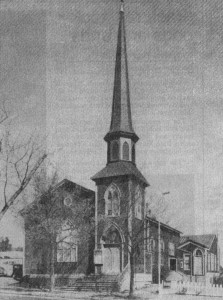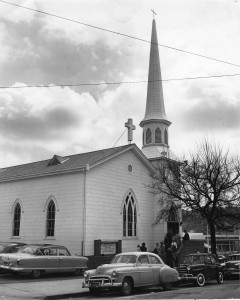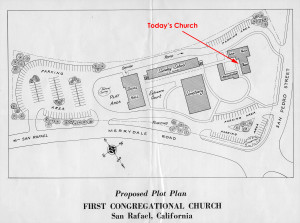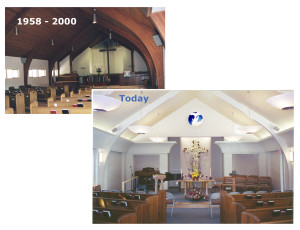First Congregational Church can trace its beginning to some fiercely independent women and the Temperance movement in the late 1800’s. In July of 1892, Emmaline Haskel and several other members of the First Presbyterian Church of San Rafael (FPC) petitioned their minister to allow them to celebrate Communion with “unfermented wine.” To their dismay, their request wasn’t just rejected, it was condemned as an “indictment of our Lord’s Last Supper,” and the minister “preached mightily” on the error of their ways.
After consideration, Mrs. Haskell and the others left FPC in November 1892 and started holding Bible Classes in the parlor of Mrs. McDonald’s Temperance Boarding House at 2nd and B streets. Their gatherings started to draw more people, and on Christmas Day 1892, they moved their informal services to a larger room at the Women’s Christian Temperance Union at 3rd and B Streets.

This intrepid group somehow connected with Rev. William H. Hardy a month later. In Haskell’s words, “He was searching for his niche as we were.” Under Rev. Hardy’s leadership, they quickly formalized their existence as an official church. They celebrated their first Communion “with pure, unfermented fruit of the vine” on March 5, 1893. FCC was legally incorporated as a church under California law in March 1894
By 1897, PFC had outgrown its original building, and it decided to build a new one at the corner of 5th and E Streets, which is its location today. We had been growing, too. In August 1897, we agreed to buy FPC’s old building for all of $1,800. This building, on the east side of E Street between 3rd and 4th Streets, was our home for the next 64 years. (Sadly, only a parking lot is there today.)

The records of our first 50 years at E Street are spotty. No pastor stayed more than four years, and there were apparently periods of serious conflict among the members. In 1947, an extended period of growth began. Rev. Paul Peterson immediately launched an extensive and badly needed renovation of our church. From that point, the white steeple of our church became a San Rafael landmark. Under Rev. Peterson’s leadership, our church’s membership grew from about 50 in 1947 to almost 300 in 1957

By the early 1950s, the neighborhoods of Terra Linda, Santa Venetia, and Los Ranchitos were starting to be developed, and our E Street church was bursting at the seams. In 1955, we bought five acres at the corner of Merrydale Road and North San Pedro Road for $30,000. By 1958, we had developed plans for a large church campus at the new location and launched a building drive. In 1960, we broke ground on the first phase of this plan, which encompassed the office and chapel, and we started holding occasional outdoor services there. The chapel, which is our present sanctuary, was dedicated on March 11, 1962. We moved the pews, organ, and other furnishings from the E Street church and sold the building.
It is not clear whether we still hoped to complete all phases of the building plan when the chapel was dedicated, but the church’s membership steadily declined in the 1960s, and it became apparent that the big project would not happen. In 1965, we started discussing other possible uses for more than three acres of surplus land. In 1969, the congregation voted to use financing from the U.S. Department of Housing and Urban Development to build a 61-unit low-income housing project on this land. Pilgrim Park is now a model for successful projects of this type. It was also a touchstone for our church, convincing us that we can and should “dream big” in the realm of benevolence, which we continue to do today
Through the 1970s and 1980s, our membership declined, and we sublet parts of the building and reduced the pastor’s position to part time. Still, loyal members and Rev. Lou Riley kept us going and actively engaged in issues of social justice.

A new era of growth began with the arrival of Rev. David Ray in 1993. Rev. Ray helped us believe in ourselves and the importance of small churches. We launched a building project that, when we started, seemed far beyond our means. Five years later, however, our sanctuary had been transformed from a dark space into a bright and inviting one.
At about the same time, we launched Every Dollar Feeds Kids (EDFK), a grass-roots program to feed and help educate the poorest of the poor in Mexico. Since its start in 2000, EDFK has raised roughly $50,000 per year locally—with no administrative expense—and has enlisted several partner churches across the country
Momentum continued under the leadership of Rev. Julianne Stokstad, who became our pastor in 2004. She brought fresh energy and new initiatives in mission activities. Rev. Tracy Barnowe became our pastor in 2014 and helped lead a marked upturn in energy and attendance. She focused our energy on several initiatives in the community, the most significant of which were after-school and summer enrichment programs for the children of Pilgrim Park.
The COVID-19 pandemic had a major impact on our activities, and our services were held virtually in most of 2020 and 2021. We recently formed a five-member Pastoral Search Committee and hope to call a settled pastor in 2025.
By the way, we still serve Communion with “the pure, unfermented fruit of the vine,” although we have been known to break out the other kind at parties.